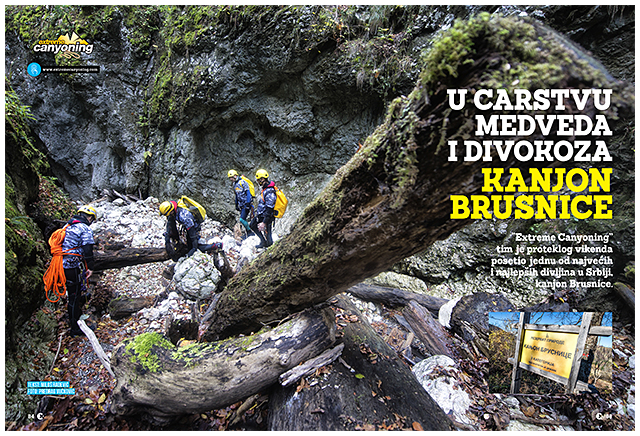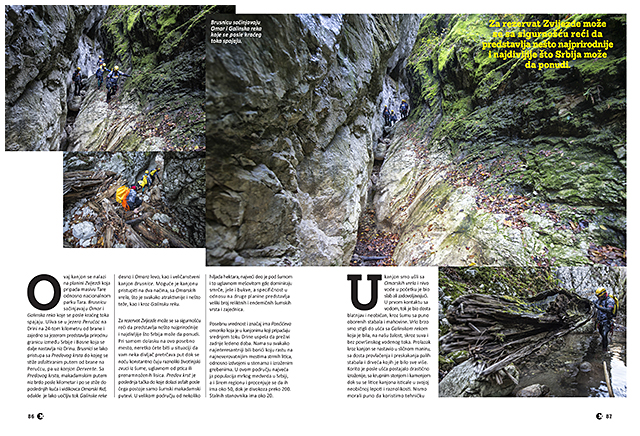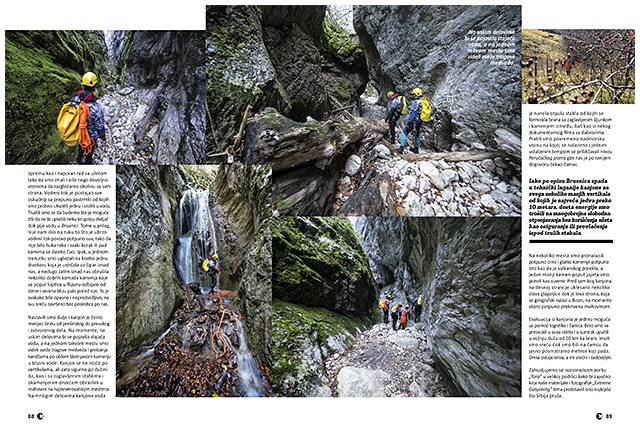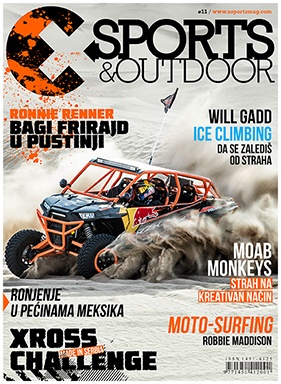Great article with high quality photographs in latest issue of X-Sports, specialized magazine for extreme and other similar sports, or better yet for all activities under the common name of Outdoor sports. Magazine promotes and covers all adventure activities and other things from everyday life that we call challenge, adventure and action. Moreover, another important task is impact on its readers to have active and healthy lifestyle. In the shadow of soccer, handball, basketball… nature sports are still experiencing huge expansion.
In the realm of the bears and chamois – Canyon Brusnica
This canyon is located on the mountain Zvijezda as a part of the Tara mountains and Tara National Park. River Brusnica is formed of rivers Omar and Galinska reka and flows into the Perucac lake located 24 kilometers after the dam on river Drina which is natural border between Serbia and Bosnia and Herzegovina. Brusnica can easily be reached from the cross of Predovo to which an asphalt road leads from the dam, and later up the canyon of Derventa. Down the macadam road from cross of Predovo after one mile you will reach the last houses and viewpoint Omar Rid from where the flow of Galinska reka is easily seen on the right and Omar on the left, as well as magnificent canyon of Brusnica. Reaching the canyon is possible in two ways. First is from Omar wellspring, which is more difficult and more attractive and the second way is through Galinska river.

The Zvijezde reserve can be said with certainty to represent the most natural and wild thing that Serbia can offer. When you arrive at this special place, you will often find yourself in a situation where some wild animal runs across your path, while at night you can constantly hear various animal sounds from the forest, mostly from birds or too many foxes. Pred’s cross is the last point that asphalt reaches, after which there are only forest macadam roads. In a large area of several thousand hectares, the largest part is under forest, mostly mixed, dominated by spruce, fir and beech, and the specificity compared to other mountains is a large number of relict and endemic forest species and communities. The Pančić spruce, which managed to survive the last ice age in the canyons belonging to the middle course of the Drina, has a special value and importance. The most interesting to us were the pines that grow on the most incredible places of steep cliffs, i.e. isolated in rocks and prominent ridges. In this area, the largest population of brown bears in Serbia and the wider region is estimated to be around 50, while there are over 200 chamois. There are around 20 permanent residents.

We entered the canyon from the Omarski springs and the water level was initially weak but satisfactory. In the first contact with the water, the flow was quite muddy and unusual, through a forest with many fallen trees and moss. Very quickly we reached the confluence with the Galinski River, which was, unfortunately, completely dry and without surface water flow. The passage through the canyon continued in a similar manner, with a lot of crawling and jumping over fallen trees and trees, of which there were more and more. After the mouth, the bed became drastically more pronounced, with large boulders and stones, while the cliffs of the canyon stood out in their unusual beauty and variety. We didn’t have to use a lot of technical equipment as well as hard work with the rope, so we had more than enough time to see the surroundings from all sides. The water course became more and more scarce with a lot of trout, of which we tentatively caught one and returned it to the water. We tried to be as quiet as possible so as not to scare some larger game while drinking water in Brusnica. In addition to that, it didn’t work to our advantage that soon the watercourse became completely dry, so there was no roar of the river and every step or fall of a stone could be heard far away. However, at one point we briefly saw a chamois that ran up the cypress tree above us, and not long after, a few good pieces of stone fell on top of us, which bounced off the rock like a pinball ball and landed very close next to us. It was certainly dangerous and unpredictable, fortunately ended without consequences for us.

We continued on and the canyon often changed width from too wide to too narrow and closed. At times, standing water would appear in the narrow sections, and at one such spot we saw fresh bear tracks and claw scratches on the round muddy rocks near the water. The canyon doesn’t stand out vertically, but it certainly does in length, as well as with stuck trees and petrified trees covered in moss in the most incredible places. In many parts of the canyon, the water washed down fallen trees, which formed a dam with gravel and stones stuck in between, just like in a beaver documentary. We occasionally followed the altitude at which we were and at a steady pace approached the level of the Perucački jezera, where the boat was waiting for us according to the earlier agreement.
In several places we found completely black and smooth stones, exactly as if they were of volcanic origin, and we took one smaller egg-like stone as a souvenir. Near the end of the canyon on the right side, several Glagolitic letters are carved, while the left side, which is geographically located in Bosnia, is at times almost completely covered with moss.
Evacuation from the canyon is only possible with the help of logistics and a boat. We quickly changed into dry suits and set off for a 20 km drive to the dam at dusk. We were lucky while on the boat to clearly observe the falling meteor. Drina remains guilty, and we are happy and satisfied.
We would like to thank the national park “Tara” for its great support so that together through our materials and photos of the “Extreme Canyoning” team we can present the most beautiful things that Serbia has to offer.
Text: Miloš Radević / extremecanyoning.com
Photo: Predrag Vučković / extremecanyoning.com

